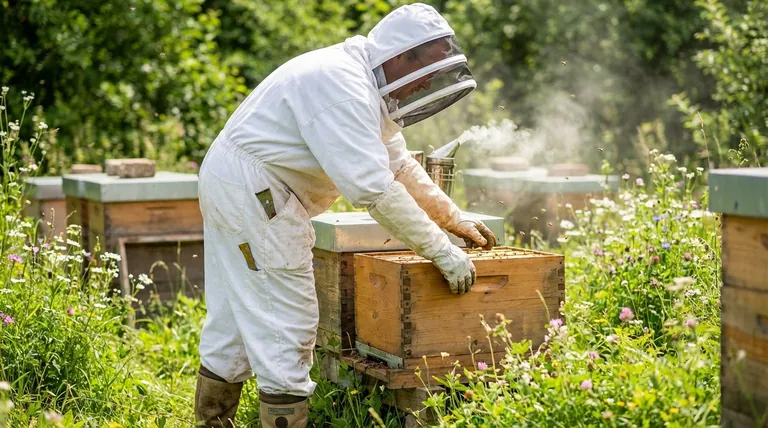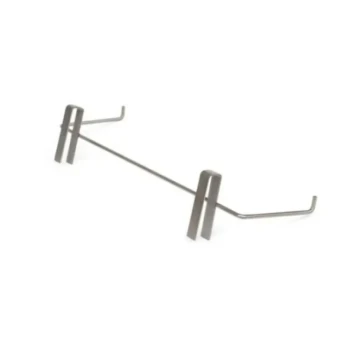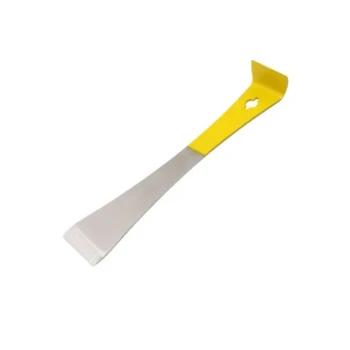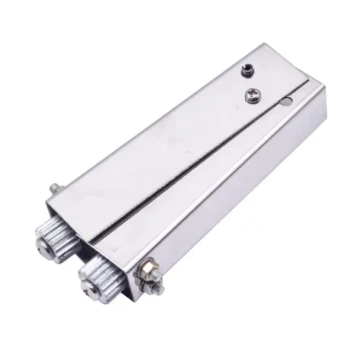At its core, a standard bee suit is a full-body garment designed to create a complete barrier between you and the bees. Its key features include a polyester-cotton blend fabric for durability, an integrated and often detachable veil to protect your head and face, and secure closures like elastic or zippered wrists and ankles to prevent any gaps. These elements work together to provide comprehensive protection while allowing you to work.
The most effective bee suit isn't just about preventing stings; it's a carefully designed system that balances total protection with the functional need for comfort, visibility, and easy access to tools.

Core Protective Elements
The primary function of a bee suit is to prevent stings. This is achieved through several fundamental design components that work in unison to seal off the wearer from the hive.
The Integrated Veil
Your face and neck are the most vulnerable areas, making the veil the most critical component. Most modern suits feature an integrated veil that zips directly onto the suit's collar, eliminating any gaps. These are typically detachable for easy washing of the suit. Common styles include the "fencing" veil for excellent peripheral vision and the "round" veil for maximum space from your face.
Full-Body Coverage
A standard suit is a one-piece garment covering your torso, arms, and legs. This single-piece design minimizes the number of potential entry points for a determined bee, unlike separate jackets and pants which can gap at the waist.
Secure Closures
Creating a perfect seal is crucial. Suits use elastic at the wrists and ankles to create a snug fit against gloves and boots. Many also include thumb ties, which are elastic loops that keep the sleeve from riding up your arm when you reach into a hive. A strong front zipper, often made of durable brass, ensures a secure closure down the front of the suit.
Material and Construction
The fabric and build quality of a suit determine its durability, comfort, and ultimate level of protection.
Fabric Blends
Most standard bee suits are made from a cotton/polyester blend. This combination offers the breathability of cotton with the durability and sting-resistance of polyester. Some lightweight suits may use 100% cotton, which is comfortable but may offer slightly less protection than a thicker blend.
Color and Texture
You will notice that nearly all bee suits come in light colors like white, sand, or khaki. This is intentional. Bees perceive dark colors as threatening, similar to a natural predator like a bear. A smooth, light-colored fabric is calming and less likely to provoke a defensive response.
Functional Design Features
Beyond basic protection, a good bee suit includes features that make the work of beekeeping easier and more efficient.
Pockets for Tools
Beekeeping requires several small tools, such as a hive tool, a brush, and a queen marker. Large, accessible pockets are a standard feature, allowing you to keep these essential items on your person and ready for use without having to leave the apiary.
Detachable Components
The ability to detach the veil is a key feature for both cleaning and convenience. It allows you to machine wash the suit without damaging the delicate mesh of the veil. It also lets you flip the hood back to take a drink or get some fresh air when you are a safe distance from the hive.
Understanding the Trade-offs
Choosing a bee suit involves balancing different needs, primarily the climate you work in and your personal comfort.
Standard vs. Ventilated Suits
A standard cotton-blend suit is not ventilated. While protective, it can become extremely hot in warm climates, leading to discomfort and fatigue. For this reason, ventilated suits have become popular. These are constructed from three layers of mesh fabric that allow for maximum airflow while maintaining a protective barrier, keeping you significantly cooler.
Protection vs. Mobility
Generally, thicker material offers more protection but can be heavier and more restrictive. A lightweight cotton suit might offer greater mobility and comfort on a mild day, but a thicker poly-blend or a ventilated suit provides a more reliable defense against stings. The choice depends on your comfort level and the temperament of your bees.
Making the Right Choice for Your Needs
Your ideal suit depends entirely on your climate and beekeeping goals.
- If your primary focus is occasional beekeeping in a cool climate: A standard cotton/polyester blend suit provides an excellent balance of protection, durability, and value.
- If your primary focus is beekeeping in a hot or humid climate: A ventilated three-layer mesh suit is a necessary investment for your comfort and safety.
- If your primary focus is maximum security and peace of mind: Look for a suit with overlapping zippers, strong thumb ties, and durable ankle closures to ensure every potential entry point is sealed.
Ultimately, the right bee suit is the one that allows you to work confidently and comfortably around your bees.
Summary Table:
| Feature | Purpose & Benefit |
|---|---|
| Integrated Veil | Protects face/neck; detachable for easy cleaning. |
| Full-Body Coverage | One-piece design minimizes gaps and entry points. |
| Secure Closures | Elastic wrists/ankles and thumb ties prevent bee access. |
| Cotton/Polyester Fabric | Durable, breathable, and offers excellent sting resistance. |
| Light Colors | Calms bees by not appearing as a threat (e.g., bear). |
| Tool Pockets | Keeps hive tools and brushes accessible while working. |
Ready to Outfit Your Apiary with Confidence?
HONESTBEE supplies commercial apiaries and beekeeping equipment distributors with high-quality, durable bee suits designed for professional use. Our wholesale-focused operations ensure you get the reliable protection and comfort your beekeeping business depends on.
Contact HONESTBEE today to discuss your bulk supply needs and get a quote!
Visual Guide

Related Products
- Cotton Beekeeping Suit and Round Hat with Veil Bee Keeper Protective Gear
- Beekeeping Jacket with Hood and Veil for Beekeepers
- White Beekeeping Protective Suit and Hat with Fencing Veil for Beekeepers
- Professional Beekeeping Suit for Kids and Girls Childrens Bee Keeper Suit
- Beekeeper Cowboy Hat and Veil for Beekeeping
People Also Ask
- What is recommended for beginners in beekeeping regarding protective clothing? A Complete Safety Guide for New Beekeepers
- Do beekeeping suits completely prevent stings? Maximize Your Apiary Safety with the Right Gear
- How should a beekeeping suit be hung to maintain its shape? Protect Your Investment with Proper Storage
- What are bee suits made of? Choosing the Right Material for Maximum Protection & Comfort
- What should be considered regarding the color of beekeeping clothing? Ensure Your Safety and Keep Bees Calm



















